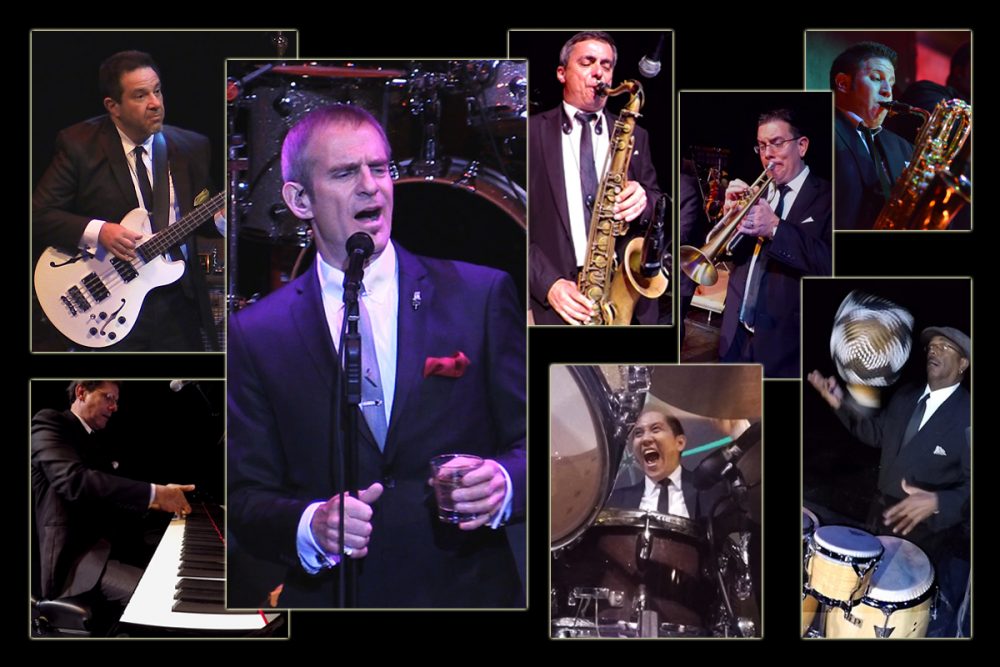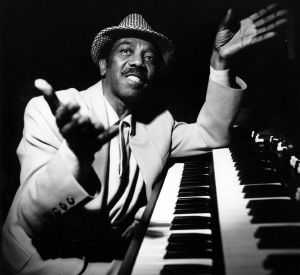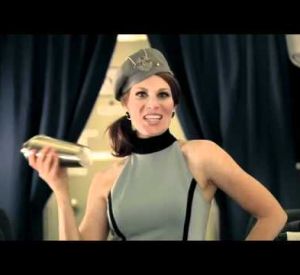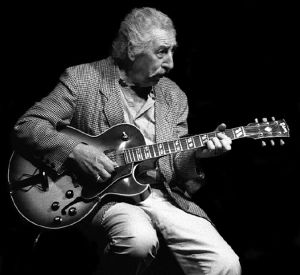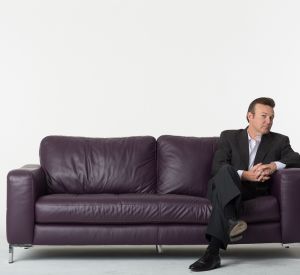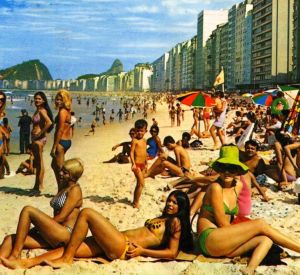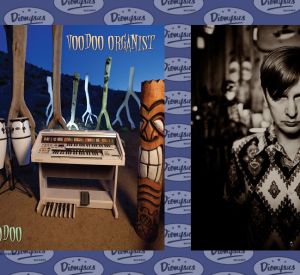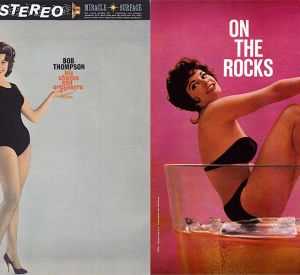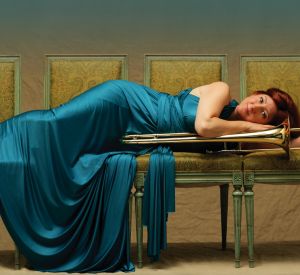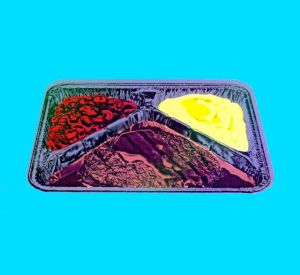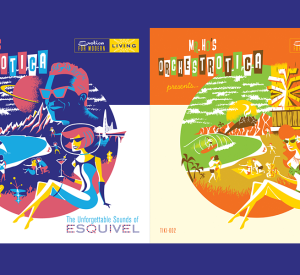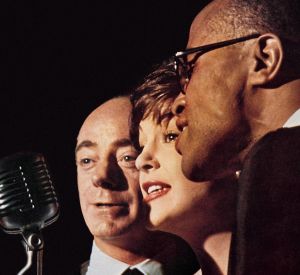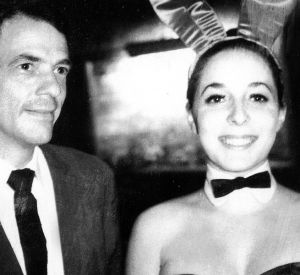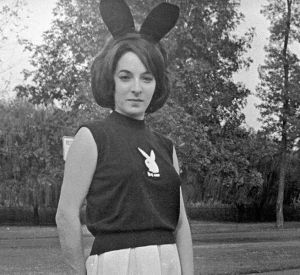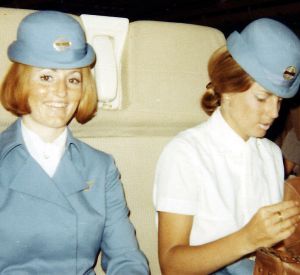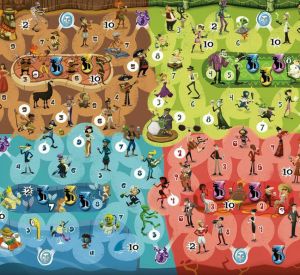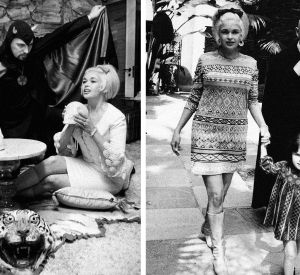Live At The Purple Pit – An Interview with Nutty
It all started with the familiar opening notes of “Take Five”. It was a lazy day off in 2012 and I was doodling at my art table with the sounds of Cocktail Nation with Koop Kooper in the background. Because the room reverb was slightly flat in the recording, I knew this version of “Take Five” wasn’t The Dave Brubeck Quartet’s original. And I was prepared to hate it.
In an instant, that changed. Instead of Paul Desmond’s saxophone coming in where it should have, there were vocals singing the lyrics to The Moody Blues’ “Nights In White Satin” in its place. And, for me, that moment was like when Carl Cohen punched Frank Sinatra in the mouth at The Sands in 1967: I was stunned. The song was “Five Nights.” The band was called “Nutty.” And I was an instant fan.
Since 2000, 1960s time-travelers Sonny Moon and Guy Wonder have often switched places with their 21st century alter-egos Joel Hile and Mike Werner to bring Nutty’s Rat Pack style swank to the shaggy world of rock and roll. Their specialty: Fine musical cocktails blending equal parts rock and jazz — Henry Mancini with Jimi Hendrix; Dizzy Gillespie with The Police; Miles Davis with The Who. And like all top-shelf cocktails, they go down smooth.
I’ve wanted to interview Nutty for years. But it wasn’t until now, with the current crowdfunding of their third album, Live At The Purple Pit, that I had any excuse to do so. Fortunately for me, and us, frontman Sonny Moon was more than willing to sit down for a nice long chat.
Baron von Swankenstein: Nutty’s been bringing its brand of jetsetter jazz to audiences since 2000 — 18 years, man! For those coming late to the party, refresh our memories: When did the idea for Nutty first come into being? And what did it take to bring that idea to fruition?
Sonny Moon: I met Guy Wonder when he showed up to audition as bassist for a band I was in with a couple of cats from a telemarketing gig I had at the time. It was a jump blues/swing/lounge project aptly named “Chase Lounge and the Lazy Boys” for its loose half-serious tone. After some rehearsals, we recorded a demo. I was already steering the project more towards a lounge take on classic rock songs and Guy and I were both embracing jazz at the time. Consequently, the guitarist became discontented with the direction and opted out. And shortly afterward, the drummer went on tour with his blues band.
So, the band was restructured with the focus being jazzy versions of classic rock. Influenced by Jerry Lewis’s The Nutty Professor (1963) and the “beat” vernacular between the 1940s and 1960s, I named the band “Nutty” and then assigned us our stage names. To this day, we still defend the band name to those who don’t get the reference to our offbeat, oddball approach!
That’s all? I’m surprised Nutty’s development was that simple.
Well, no, it wasn’t. From 2000 to 2004, phase one of Nutty comprised piano, guitar, bass, drums, tenor sax, trumpet and vocals. With this lineup, we recorded our debut album. It was a work-in-progress, to say the least. We were still trying to find our purpose and style. For a few of the songs, we hired drummer DJ Bonebrake from X to play vibraphone and jazz notable Carl Saunders to play trumpet. A session string quartet also came in to play on our Thin Lizzy tune. The record was good but still not representative of our potential. In the meantime, we played the Derby, the Lava Lounge, and other local L.A. bars for little to no bread to get our live chops perfected. But the band wasn’t there yet.
Fed up with Los Angeles, I made a drastic move to Portland, Oregon in 2004. But after about a year and a half, I realized I needed to get back to So Cal and start again. Guy stayed busy with his day job and the occasional studio work and when I returned we got back into gear.
Obviously, that’s not the whole story.
No. No. In early 2006, we searched for new players and Nutty-phase two began. Our goal was to find exceptional jazz musicians and to create legible challenging arrangements for them to play. This was a learning experience for us. And this is where we honed our niche of blending classic rock songs with classic jazz numbers to become Nutty quasi-originals. Personnel were in constant rotation and the players got better as we and our reputation grew. Several guitarists later, we’d decided to lose that instrument completely in an ironic decision to create all rock guitar parts with horns. We had a vibraphonist for a spell. We even had a trombonist for about a month. It became a septet, replacing guitar and vibes with a baritone sax; Plus, both our tenor and baritone sax players now also played flute. Shortly afterward, a percussionist was added to the lineup and then there were eight.
So how did you get from there to the here-and-now?
We played more and more clubs and, in 2009, we initiated a second studio album. This record was a more accurate mission statement. However, it took us almost three years to complete because of delays and issues with some of the people involved. From that album to this new live one that we’re attempting to now finish, we’ve been hell-bent on staying true and unique, branding our sound and style “Jetsetter Jazz.” The current lineup is our best band to date, with a roster of top shelf subs as backup.
You’ve said in the media that Nutty was on a holy mission, so to speak, to bring jazz to audiences — particularly rock audiences — that typically ignore jazz. Despite originating here and being 100% American, jazz is the least popular form of music in the United States today, according to a 2014 Jazzline report. Personally, I blame it on the rise of post-fusion smooth jazz; but that’s just me. Why do you think Americans lost interest in jazz?
I think it’s a combination of things that happened over a span of time. I’ve read that many people lost interest in jazz initially when it became more esoteric and self-involved and less singable and danceable. Bop came along, which was still really cool, but more intimate and more intricate. And jazz cats just started playing more for themselves without as much regard for the entertainment aspect. Fusion, which got even more difficult to follow and groove to, continued to take the “song” out of jazz. And smooth jazz, what I like to call “laxative jazz:” Don’t even get me started!
When jazz began as America’s original music, it was good-time jazz and big band and crooner music was the “pop” of the day. Cats dressed sharp and considered presentation a part of the repertoire; but like styles in general, people lost sight of swank and charm and doin’ the do. Also, rock n roll music began to take center stage in the mid to late ‘50s, gradually gaining popularity — and drastically elevating sales — over jazz for record companies. There just wasn’t enough bread in jazz anymore.
So how goes your crusade today?
It’s tough but we’re determined. We’re up against fickle crowds who don’t really dig jazz. And there’s that jazz crowd that frowns on anything that’s not “pure” — whatever the hell that is! Our mission is to make jazz fun, not to make fun of it. Ask most musicians and they’ll tell you that “jazz” is a dangerous word if you wanna work and make money. Contrary to popular opinion, however, jazz is not dead. It just needs to lighten up. And swing hard.
Do you find that people are coming along?
Nutty has converted people. We’ve not only made jazz music — classic jazz music — more palatable to fresh ears but we’ve also made new fans of jazz purists — including jazz journalists — who get that our music is serious business no matter how much fun we’re having. We’ve had people that don’t know how to spell jazz go home and research Wes Montgomery, Thelonious Monk, Cannonball Adderley, and the other great jazz cats. We’ve had students come to listen and ask us questions. And we’ve lent a couple of charts out to college concert and marching bands.
We love to hear people tell us that they enjoy a rock song they never really liked before until they heard our version; Or how they get through traffic or a long drive with Nutty blasting on their car stereo. The compliments that validate us most are: One, our arrangements are mind-blowingly clever. And, two, we are engaging from start to finish. This is what keeps us going.
I want to add that our shows are part of the reason people even pay attention. In that glorious short period that was the Rat Pack era, Sinatra, Martin, and Davis had people in the palms of their hands because they were entertainment personified and people wanted to have the fun that they were having on stage. We try to emulate that vibe and that moment in time with what we do. With classic rock. Pretty nutty, huh?
Other acts who do musical style switches — Richard Cheese, for example — focus on popular songs that are currently in rotation in the media. This seems a good way to gain acolytes to the jazz faith. Yet Nutty prefers to focus on older classic rock. Why?
Richard Cheese is doing Bill Murray’s “Nick The Lounge Singer” act, which is what I was into doing in the late ‘80s and then later with the “Lazy Boys” project. Too much tongue-in-cheek. He’s really just a stand-up comic with a lounge combo in the background. And he’s good at it. But we wanted to do more than that. We wanted the songs to prevail. Come for the humor; stay for the music.
We choose the classics because we feel they are worthy. They are better songs that have stood the test of time. And we’ll argue all day long that most of the current material covered by Cheese or Postmodern Jukebox and the like are evanescent and won’t get past the joke. Let’s face it: A lounge version of a hardcore rap number is a gag and it’s not gonna be around for posterity. Granted, it’s not all like that; but it’s the trend. And, frankly, we just dig the classics. It’s the music that we grew up with.
But there’s no doubt that dropping a few bars of the “Gilligan’s Island” theme into your mashup of “Manteca” and “Message In A Bottle” is also a bit of wry humor too. Yet Nutty doesn’t sneer at the source material as those other bands might. Where do you find the balance between the humor and respecting the source material?
Well, I think, because we care about the music, we just know how far to step outside of serious. At the same time, humor is very much a part of what we do. And we’re huge fans of those film and TV themes of that era. All of that stuff — even the cartoons — had themes written by great jazz and standards composers.
How do you know when you’ve gone too far?
There are no steadfast rules. We just know where it works and where it doesn’t. It’s a sensibility. The criteria’s always the same: Will people get this? Does the material blend well? Does the song groove? Does it swing? Are we making them laugh? And, at the same time, are we giving them something to savor and take away with them? We love to watch the audience and their reactions to what we do — when the light bulb goes on above their heads. I’m always gauging them to see what’s working or not.
Are there any songs, jazz or rock, you’ve really wanted to do that you’ve been unable to do?
Well, there were a few that didn’t quite come together. Either the lyrics of a song didn’t work or the song wasn’t quite familiar enough to resonate. It’s really all about fitting together the right pop or rock song with the right jazz number. And it begins with instinct and inspiration. Sometimes it’s effortless and, other times, it’s a real challenge. Guy and I generally like the same material from both the rock and jazz milieu; although I would say his range is broader than mine.
Are there any songs you’re absolutely determined to “nuttify?”
There’s stuff that lingers and we’ll get around to it. When we started out, we tried a few that just didn’t work the way we’d hoped. One was Elvis Costello’s “Watching The Detectives,” which, in theory, was good crime jazz. It never worked the way we tried it; so we tossed it. But that doesn’t mean I don’t have another idea for it, ‘cause I do. We wanna do Bowie but nothing has stood out and said “Do me! Do me!” yet. I like the idea of doing “Cha-Cha-Changes,” which is pretty self-explanatory.
What about stuff from the jazz side of things?
One jazz standard we’ve always talked about doing was “Fever.” But that’s a tough one to match with a rock tune without losing the essence of Peggy Lee’s rendition.
What else?
I do have a Paul Simon tune in mind that I’d really like to try, but we’ve not tackled it yet. It may be next. I can’t tell you the name of the song yet, ‘cause then I’d have to kill you and all of your readers. “Free Bird” is another one I keep toying with, at the risk of turning Bill Murray. It’s one of those songs you just wanna hate. But I have this idea: Think Weather Report.
What about Guy? Does he have anything just itching to be made?
Guy has his personal obsessions as well. He’s got a Deep Purple versus Mingus chart he keeps saying he’s bringing to the table soon. And he’s mentioned he’s working on something with the jazz tune “Whisper Not” which, he says, came to him in a dream. Then there’s a piece he mysteriously refers to as “The Windmills Of The Wall.”
The bottom line is neither Guy nor I like to force anything; it has to feel right to begin with. That doesn’t necessarily mean it’s gonna be easy — just do-able. One of us will bring in an idea or concept; then we’ll both hash it out. And, believe it or not, we’ve both come up with the same ideas on occasion.
Nutty’s had some great gigs over the years including Sheila E’s E Spot Lounge and especially Herb Alpert’s Vibrato. Get any good feedback from the owners? Any stories? Should we expect to hear “The Lonely Bull” or “A Taste of Honey” from Nutty in the future?
Hmmm…. Just about anything Herb Alpert and The Tijuana Brass did could qualify and it’s very likely we’ll work something up for an upcoming Vibrato show. We’ve been so busy with marketing and finding gigs and new fans that we’ve been negligent in creating new material. But we’ve got some goodies in the works.
However, to answer your question: Herb Alpert is a swell guy. I met him many years ago — before my jazz days, before I knew about his club. I had a blues rock band then and I had a day job driving limos for Music Express. He was a client and I’d driven him to the airport a couple times. I told him that I took up the trumpet in 6th grade because of him and his music; He got a kick out of that. I’ve not seen him since then. He hasn’t been at the club whenever we were in there. But his daughter and co-proprietor, Eden Alpert, is a big fan and was instrumental in getting us in. I hope he shows up at one of our upcoming gigs.
What about Sheila E?
We never dealt with Sheila E. We were already playing Vitello’s [location of the E Spot Lounge —BVS] before she came on the scene with her bread and her influence. Inevitably, the whole E Spot thing went south because of her disregard for protocol and the excessive noise she and her entourage created. After she split, it was about eight months before we or any other electric band could play there again because of a neighborhood petition to completely shut down any music with a decibel level. That joint has been through so many changes over the years! But we’re still there.
I’d say it says something about Nutty’s musicianship to be able to gig at those places, though.
We worked hard to get in the door at both clubs. But it’s not really about how good you are — although that’s what got their attention. It’s all about how you draw. Can you fill the house? And that’s tough to do in this town. This is the case with all of the places we’ve played and, sadly, most of them are gone now.
Let’s talk about the new album, Live At The Purple Pit. It’s Nutty’s third album overall and your first live album. Since you’re showcasing new material, why a live album instead of a new studio effort?
The expense, for one thing. Studio time is costly. And I’m a perfectionist. So time has a way of slippin’, slippin’, slippin’. But more importantly, we’re very proud of our abilities as a live band. This record is about a Nutty show and the engagement with the audience.
A lot of live albums that have been produced suffer from bad production. But when it’s done right, it’s magical. The place we’re using to mix and master is giving us a great sound; so we’ll have that studio quality with the cozy vibe of a club gig. In a perfect world, I’d have Nutty in Capitol Records Studio A recording exactly the way Sinatra did it in the late ’50s, live in the studio. One day. Maybe.
For those of us living outside of California, this will be the first time we’ll be hearing a complete Nutty show. What’s in a Nutty show that’s missing from studio recordings?
Well, the show! The spontaneity! The irreverent humor! The banter! The interaction! We like to let it leak a little into our studio tracks but there’s no audience.
I should add that it wasn’t the complete show. In the chaos of putting this together, we had some technical and performance issues and some of the songs didn’t make the cut. Also, a few of them were reworked since we played them that night. So we wanted to do the newest iterations of them next time around. We picked the nine songs that really shined and formed the album around them.
What have you accomplished with the new album that you thought didn’t happen with the last two?
It’s more in the moment. On the first album we were figuring it out as we went. We hadn’t found our sound yet. The second album was more focused and polished but scheduling problems, personnel changes, and personal issues caused a lot of delays. It was done at a home studio; so there were limitations. We also experimented a lot with room sounds. And, whenever we could get in, we went to the Clark Library near USC to record piano tracks on a 1928 Steinway concert grand and to record room reverb. There was also a lot of overdubbing and fixing going on.
For this new record, we recorded it live and the band is better. We’d only have to fix a few things with the selected tracks in the studio for the sake of sound quality and show continuity.
For the past 18 months or so, some of the songs slated for the album have been previewed on your YouTube channel. Are those the recordings we’re going to hear on the album? Or are these new takes we haven’t heard yet?
There are two videos that are takes from the actual show — “That Old Black Magic Woman” and “Magic Trane Ride.” Two others — “Four On KISS” with Bruce Kulick and “The Sunglasses Crowd” — are from different shows. And there are a couple of different cats playing on those song videos as well. You’ll be hearing newer versions of those two songs and then five more previously unreleased tracks.
Speaking of “Four On KISS,” I understand former KISS guitarist Bruce Kulick is a friend and Nutty debuted the KISS/Wes Montgomery mash-up at his wedding reception. With Gene Simmons himself in attendance! What was the reaction?
Bruce’s wife, Lisa, had turned Bruce on to us. He became an instant fan. And the second time he saw us play, he approached me about playing at his wedding. We decided not only to take the gig but to create a KISS song for the show. We played the tune in the first set. During our break I jokingly said to Gene, “I hope we didn’t fuck your tune up too much.” To which he quipped, “I came twice.”
“Four On KISS” has become a staple on Nutty’s set lists and one of the YouTube videos previously mentioned shows Bruce playing his guitar with us on stage for a rendition of the KISS tune. He’s become an avid fan of jazz and now he digs Wes Montgomery! We like to talk Beatles and Sinatra a lot.
Have other original artists reacted to Nutty’s interpretations of their material?
We’ve often mused about the effect we’d have on the original artists that we cover, and even reached out to a couple through odd channels, to no effect thus far. Bruce did give a rough live take of our Alice Cooper song to producer Bob Ezrin, who goes way back with Alice. As far as I know, Alice listened to it but I’ve never heard back either way. I guess the closest we’ve gotten to a response — other than Bruce and the KISS connection — would be Carole King’s former manager, who came to see us with a mutual friend. When she heard our Monkees tune, which Carole wrote with Gerry Goffin, she said that Carole would dig it. I’m really hoping that we do reach some of these artists and that they share a positive reaction. Imagine the buzz that could create.
You’ve got Shag as cover artist for the new album. How’d that come about? I mean, as The-Duke-A-Number-One of retro artists, he doesn’t come cheap?
Yeah, he gave me a pallie rate; but he still wasn’t cheap. When I met Josh ten or so years ago at a retro gathering in Vegas, I showed him our first album cover, which I’d done to save money. I still have that CD with his signature and “I Approve” on it. I’d since talked to him over the years about doing something for us but it didn’t come together until recently. He’s made it clear that he only wants to create his art for what appeals to him, so I’m proud to say that he chose to create for Nutty. I sent him a synopsis of what I wanted the album cover to look like, along with a rough mix of the tracks, and that sealed the deal. That and a check.
Did the resulting album cover meet your expectations? Is this what you expect fans to see in their heads when you describe Nutty?
It absolutely did. I had to ask for some changes over a few details, but they were minor. I first laid out the concept of the cover for Josh with a vision of Nutty’s world and a familiarity with Shag’s version of that same world: I wanted to show this image of Nutty rolling up in one of my all-time favorite classic cars — a 1962 Cadillac Eldorado Biarritz — to this fabled swank haunt of old Hollywood, The Purple Pit, which is another reference to Jerry Lewis’ The Nutty Professor. Alas, no such club exists here. And clubs that were once like it are long gone. But leave it to Shag to create the illusion!
I wanted the cover art to beckon the listener inside for Nutty’s show — where it’s at, where the in-crowd is, where you can escape into a greater time than where you’re comin’ from. That’s what Nutty is all about: the escape. So yes: I very much hope that fans get this image when they think of Nutty. I knew that Josh would get it right.
Any plans or goals once the new album’s finished and at the duplicating house?
To carry on. We’ll hopefully have more time to get back to what we do best: Create more music. We’ve got the club gigs scheduled but we’re trying to branch out. Los Angeles limits us and our potential. It’s time for us to expand our horizons. I want the band to tour, play the world, and elsewhere. We’re currently searching for an agent with a clue.
Well, good luck, Sonny! Thanks for your time. Stay swank.
Nutty’s third album, Live At The Purple Pit, is currently crowdfunding at IndieGoGo.


